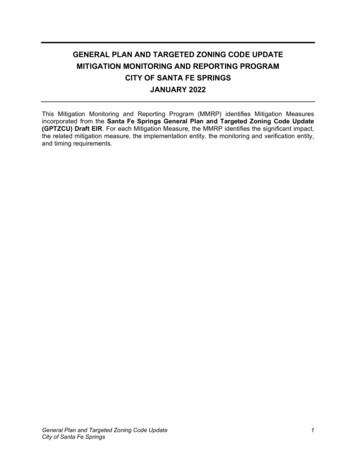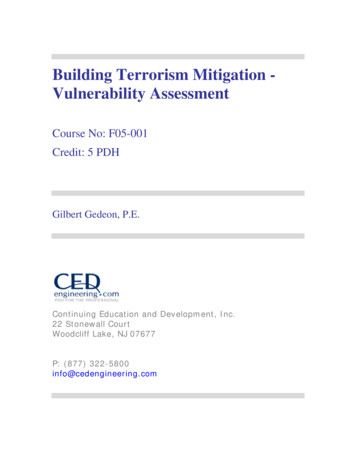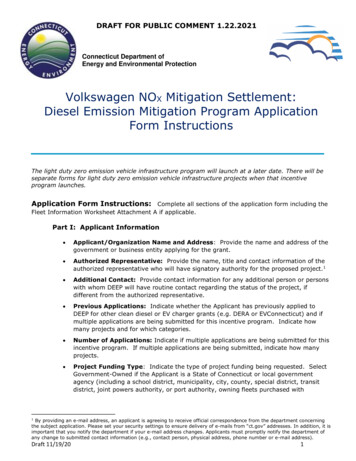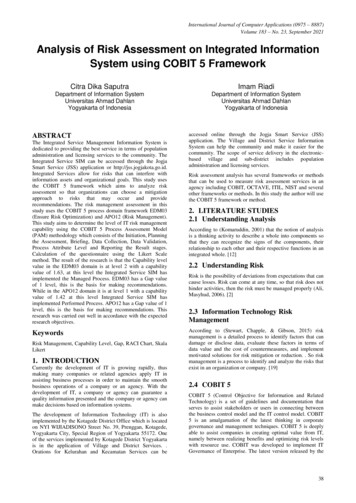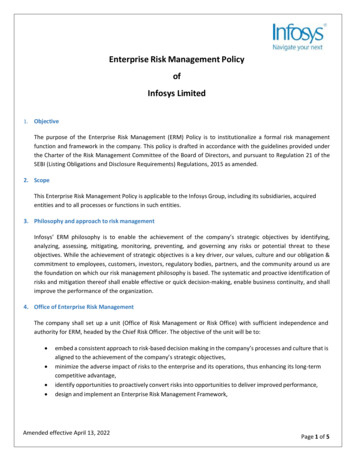
Transcription
Risk Assessment and Mitigation Strategies for Applied Behavior Analysis:Treatment of Children with Autism During a PandemicWritten for ABA Providers in MichiganMay 28, 2020Michigan Taskforce on ABA Treatment During the PandemicWith support from:1
Lead Authors*:Krista Clancy, Ph.D., LBAWayne State UniversityJosh Plavnick, Ph.D., LBAMichigan State UniversityCollaborating Authors*:Colleen Allen, Ph.D.Autism Alliance of MichiganAngela Capuano, Ph.D.University of Michigan DearbornJacob Daar, Ph.D., LBANorthern Michigan UniversityKeith English, M.D.Michigan State UniversityWayne Fuqua, Ph.D.Western Michigan UniversitySharon Milberger, Sc.D.Wayne State University, Michigan Developmental Disabilities Institute, Michigan LENDScott Schrum, M.S.Residential Opportunities IncorporatedJane Turner, M.D.Michigan State University, Michigan LEND*Authors listed alphabetically2
Risk Assessment and Mitigation of COVID-19 or Other Infectious DiseaseThe novel Coronavirus 2019 (COVID-19) pandemic requires several adjustments to the delivery ofapplied behavior analysis (ABA) services for individuals with autism spectrum disorder (ASD). Newinformation about the virus, our ability to treat it, and strategies to mitigate spread is generated on adaily basis. In addition, daily fluctuations in cases within a specific region impact that region’s capacityto provide public health to all who may need it. As of May 2020, projections suggest a 12-month orlonger scenario in which the pandemic could factor into how services are delivered.The present collection of tools is designed specifically for Michigan’s ABA providers to assess andmitigate risk to clients, families, and staff while still delivering essential services to the extent that it issafe to do so. Please note these tools do not supersede executive orders from the State of Michigan.Providers should be familiar with state requirements, as well as conditions in their individual regions.The Michigan Department of Health and Human Services and Local Health Departments can provideadditional sources of information should users have uncertainty after completing the attached tools.The tools in this document consist of (1) a Regional Risk Assessment to better determine the extent towhich COVID-19 prevalence in a given area impacts service delivery considerations, (2) anIndividualized Risk Assessment to help providers determine the need for various risk mitigationstrategies for a given client or family, (3) an example of a Daily Health Screening Tool to makemoment-to-moment decisions about providing treatment to a specific client on a specific day, (4) aRisk Mitigation Worksheet (adapted from Mullen et al., 2020) that providers can use to generateagency-wide and individualized risk mitigation protocols to protect the safety of clients, families, andstaff; and (5) Parent Guidelines which may be useful to providers as they work with parents/families toprepare safe service delivery and as a stand-alone tool for families to use. Providers may find it helpfulto modify the tools for their specific needs. The authors encourage such modifications, yet suggest carein following the overall strategy of assessing risk at regional and individual levels, developingsystematic risk mitigation plans, and obtaining informed consent from all involved in in-persontreatment. A flowchart for using the tools to assist in decision-making can be found on p. 13. It isincluded to offer guidance in but not mandates for making decisions.These tools are designed to be used in combination with one another where the regional andindividual risk assessments intersect to assist in selection of risk mitigation strategies. In addition,providers must carefully assess the need for in-person services for a given client and determinewhether alternative approaches (i.e., telehealth) are viable (see Colombo, Wallace, & Taylor, 2020;Cox, Plavnick, & Brodhead, 2020; see also Autism Alliance of Michigan considerations for families).Briefly, providers are strongly encouraged to rely upon telehealth services only in situations where it isa viable treatment option. If a client’s behavior places him or herself, or their caregivers, at risk ofphysical injury or exposure to COVID-19, or if the client is likely to experience significant regressionwithout in-person services, then in-person services should be considered with proper risk assessmentand risk mitigation strategies.Given the variation in types of providers as well as individual client needs, it is impossible to provide aformulaic set of instructions. Instead, we recommend agencies and individual providers use the3
included tools, along with the Professional and Ethical Compliance Code for Behavior Analysts(Behavior Analyst Certification Board, 2019) to make decisions about how to provide treatment assafely as possible. Several additional resources and articles arising out of the COVID-19 pandemic canbe found in the references and links throughout this document.Michigan is currently using the MI Safe Start Plan to establish phases of lifting restrictions on businessand social interactions for 8 regions across the state. There are six phases in the plan, with Phase 1indicating extreme caution and Phase 6 representing a post-pandemic context in which all typicalservices can resume. ABA providers are strongly encouraged to incorporate these phases into theirrisk assessment and mitigation practices as the phases correspond to COVID-19 prevalence within aspecific region.Table 1 presents an example of how providers might adjust service delivery based on their region’s MISafe Start phase. It is important to remember that each provider will need to make individualizeddecisions, both for their agency and for individual clients within their agency. Table 1 simply outlinesone way to consider aligning service delivery environments with the phases.4
Table 1. Example of alignment between MI Safe Start Plan and type of service agencyContextsfor ABAProgramIn homePhasesin MI1 - Uncontrolled2 – Persistent Spread3 - Flattening4 - Improving5 - Containing6 – PostPandemicIn-person service for extremecases only; All who can wearpersonal protectiveequipment (PPE); Frequenthandwashing and sanitizationof surfacesIn-person service forextreme cases only;All who can wear PPE;Frequent handwashingand sanitization ofsurfacesSome servicesconsidered for childrenor families whodemonstrate high need;staff work with singleclient; All who can wearPPE (teach clients);Frequent handwashingand sanitization ofsurfacesServices for increasednumber of clients; staffwear PPE, children taughtto wear PPE; minimizenumber of people inhome; staff supportsingle client; Frequenthandwashing andsanitizationServices providedfor most clients;daily monitoring ofhealth; Consider useof PPE; Frequenthandwashing bestpracticeIn-clinic groupmodel (multiplepeople in samespace)Telehealth onlyNo in-person servicesTelehealth onlyNo in-person servicesTelehealth onlyNo in-person servicesPotential for someservice if physical spacingguidelines are met;possibly a staggeredschedule; All wear PPE;Frequent handwashingsanitization; Implementdistancing protocolsRegular serviceswith consent fromall parties,monitoring ofhealth; Frequenthandwashing andsanitization;Continue entbestpracticeIn clinic 1:1 model(one client and onestaff in adequatespace)In-person service for extremecases only; Staff work withsingle client, separated fromall other staff and clients;Supervision providedremotely; All who can wearPPE; Frequent handwashingand sanitation of surfacesExtreme precautionstaken to separate allclients from one another;staff works with only oneclient; Supervisionprovided remotely or at adistance; All who can wearPPE; Frequenthandwashing andsanitation of surfacesExtreme precautions toseparate all clients fromone another; considerphased return; staffworks with only oneclient; Supervisionprovided remotely or ata distance; All who canwear PPE; Handwashingand sanitation ofsurfaces; Implementdistancing protocolsEnsure appropriatespacing, minimizingnumber of people in oneroom. Some supervisionin person, with care toprotect all parties; Allwho can wear PPE;Handwashing anddistancing protocolsServices provided asusual with consentfrom all parties,monitoring ofhealth; Continuehandwashing anddistancing ctice5
Table 1 cont’d. Example of alignment between MI Safe Start Plan and type of service agencyContextsfor ABAProgramResidentialPhasesin MIService deliverycompliant withGovernor’sExecutive Orders(e.g., EO 2020-6 andEO 2020-50) and/orthe guidance ofMDHHS, LARA, orCDC.1 - Uncontrolled2 – Persistent Spread3 - Flattening4 - Improving5 - Containing6 – PostPandemicSocial distancing to extentpossible; Frequenthandwashing and sanitationof surfaces; All who can wearPPE; Staff restricted to thefewest locations and clientspossible and practical; Staffworking with COVID-19 casesor presumed positive are infull PPE.Social distancing to extentpossible; Frequenthandwashing andsanitation of surfaces; Allwho can wear PPE; Staffrestricted to the fewestlocations and clientspossible and practical;Staff working with COVID19 cases or presumedpositive are in full PPE.Social distancing toextent possible;Frequent handwashingand sanitation ofsurfaces; All who canwear PPE; Staffrestricted to the fewestlocations and clientspossible and practical;Staff working withCOVID-19 cases orpresumed positive arein full PPE.Social distancing toextent possible; Frequenthandwashing andsanitation of surfaces; Allwho can wear PPE; Staffrestricted to the fewestlocations and clientspossible and practical;Staff working withCOVID-19 cases orpresumed positive are infull PPE.Service deliverycompliant withGovernor’sExecutive Ordersand updated policy/procedure fromMDHHS and LARA.Staff and individualsgiven wider rangeof contact witheach utiveOrders andupdatedpolicy/procedurefromMDHHSand LARA.6
Regional Risk AssessmentThe purpose of a regional risk assessment is to understand prevalence in a given area and the extent towhich local medical systems can or cannot handle new cases. Hospitalization is one of the mostimportant environmental variables for ABA providers to use when considering methods for deliveringtreatment. The sections below will provide reference to data that is based on regional numbers.Reference the MI Safe Start Plan and MI Safe Start Dashboard to help you identify which region you arein and its overall level of risk.Hospitalization statistics (hospital beds and patients admitted) allow for assessing capacity of themedical system to treat infected individuals. Lower hospitalization ratios indicate medical treatment ismore readily available for severe COVID-19 cases while higher hospitalization ratios suggest a decreasein availability of medical attention. Hospitalization in Michigan’s 8 regions can be assessed -406-98159-523641--,00.htmlCase identification may be useful in addition to hospitalization, though providers should considerpercentage of positive cases rather than total positive cases, as the form is not biased by increases ordecreases in testing. Case identification in Michigan’s 8 regions can be evaluated -406-98163 98173 99225---,00.htmlAlthough assessing cases and deaths can provide information about COVID-19 in a given region orcounty, we caution users to remember that testing reliability and availability may interfere with casedata and that death counts represent a lag of several weeks or more between infection and reporteddeath. We again emphasize the importance of hospitalization data for your region. A complete riskassessment combines the phase for a given region along with individualized assessment data fromthe Risk Assessment Tool to make decisions about mitigation strategies.Although the MI Safe Start plan does not specify criteria for movement between phases, the MI SafeStart Dashboard identifies phases each region is in for a given day. Providers should also considerstable or downward trends in hospitalization data to determine the most appropriate course oftreatment provision for their region. This can be used in collaboration with the information gatheredon the organization and client using the tools below to make a decision about the safety of providingtreatment on an individual basis and what considerations need to be made to mitigate risks associatedwith providing services.Implementation of consent to treatment policies:All staff, clients and family members involved in or exposed to those in treatment should have athorough and accurate pre-treatment disclosure of their risk of contracting an infectious disease duringregular treatment contact, strategies being used to mitigate such risk, and the risks associated withaccessing medical treatment for that disease. It is important that clients, their family, and staffthoroughly understand the risks and benefits of accepting, postponing, or declining care prior todetermination of how to proceed with that care. Without information about the extent of the risks andbenefits of the treatment modality recommended for optimal progress with minimal risk, families andstaff do not have the ability to make important choices. If staff determine there is too much risk forcontinuing to provide services, employers will have to determine the most appropriate way to providestaffing where face to face services are needed. This may mean that staff who are unwilling or unable7
to provide the work they were hired to do may not be able to continue to hold those positions wherethey are unable to complete the job requirements for extended periods of time.Similarly, families should be able to choose to place in-person treatment on hold while not losingaccess to services in the future. However, families should not expect that providers will be able todeliver services for a similar intensity as can be delivered in-person. Consent forms should bedeveloped that outline the risk factors and options for treatment that are available, as well as, anyorganization-specific risk mitigation strategies that can be used to reduce the risk.Liability and Legal Consultation:Although, consent is necessary to move forward with treatment under these new conditions, consentgiven to continue treatment under a situation where undue risk occurs does not absolve providers ororganizations from their legal responsibility to do no harm. Therefore, the following assessment toolsshould be used to ensure the treatment decisions that are decided on during this time are the mostappropriate and are in the best interest of the client. Organizations may want to discuss differentscenarios of treatment engagement with a legal representative to determine liability for individualorganizations and situations.Additional Resources for Employers/EmployeesState of d States Department of Laborhttps://www.osha.gov/SLTC/covid-19/Centers for Disease Control and PreventionRe-opening Office Spaces: y/officebuildings.htmlRe-opening Businesses: y/guidancebusiness-response.htmlOSHA guidance on Preparing Workplaces for COVID 0/03/OSHA-covid19-prep.pdfStandard Mitigation PracticesBased on what is now known about COVID-19 as well as several approaches to conceptualizing howABA therapy can be delivered given the general risk, there are several mitigation practices that shouldbe in place if a specific region falls in Phases 1-5. Although COVID-19 is too new to have specific ‘bestpractices’, providers should consider the following new standards to incorporate in all treatment plansas both tasks for staff to complete during their interactions with others (staff and clients), as well as,providing training for clients on these ‘best practice’ strategies until reaching a post-pandemic status.Note that additional individual mitigation strategies will be developed for most clients based on resultsof the individualized risk assessment. Monitoring symptoms (Child Symptom Monitoring Protocol; Coronavirus Safety Practices forCritical Workers)o Complete Daily Health Screen for staff and clients.8
o If there are any positives from the screener or temperature checks, recommend seekingmedical attention (e.g., testing), and ask the family or staff to quarantine for 14 dayswhile providing telehealth services only.o Wash or sanitize hands and go to assigned area in center, keeping in mind socialdistancing guidelines.Facemasks and social distancing (CDC Guidance for Childcare Workers)o All staff should wear a face mask at all times while at work. Consider wearing faceshields if working with clients with spitting behavior. Temporarily suspend parentobservations and visitors into centers, and instead offer telehealth observations of clientsessions.o Consider meeting clients at their cars for pick-up and drop-off to decrease contact inwaiting rooms.o Place group sessions on hold unless social distancing requirements can be met, orconsider doing groups using video-conferencing software.o Consider additional precautions for individuals that engage in serious and challengingbehavior. If it is determined that center-based services are the most appropriate,consider having additional team members assigned to the client to assist with anyphysical safety that might be needed. Consider having those additional team membersreserved for that client only, to reduce the number of contacts that each client/staffhave.o Reduce the number of clients that one staff member works with per day. If staff do workwith multiple clients, allow plenty of time to clean and sanitize workspaces, change PPEand clothes, and wash hands.o Reduce number of clients seen by clinic to support necessary distancing requirementsCleaning and Sanitizing (MDHHS Guidance on Sanitization)o Utilize extra staff to sanitize bathrooms between each use and to act as runnersbetween rooms to deliver food, toys, data sheets, timers, or other requested items(with gloves on).o Sanitize common rooms between uses.o Sanitize bathrooms frequently and possibly between uses.9
Individualized Risk AssessmentEnvironmental Considerations:To assist in determining the risk of providing behavioral health treatment, the modality and location ofthat treatment must be considered. The following sections should be completed regarding the level ofrisk based on the environmental variables that exist in different treatment environments. Based on thelevel of risk; involved providers and families may determine that services would be best discontinued,delivered via telehealth, offered in home or in clinic. If face to face services will continue, considerwhether home or clinic-based services offers the least amount of risk for the client, family and staff.High risk in one setting may indicate that treatment should be temporarily shifted, If possible, to analternative location. For example, if you are currently doing home-based services, but there arenumerous family members in a small house and you are not confident that you can keep yourworkspace disinfected it would be less risk to the staff to have the services in a center-basedenvironment until the region is in phase 6.1. (0 minimal risk, 1 moderate risk, 2 more than moderate risk)IN-HOME: Risk Consideration0122. (0 minimal risk, 1 moderate risk, 2 more than moderate risk)CLINIC: Risk Consideration012Size of treatment space (0 ample space enabling at least six feet in betweeneach workspace and others in the environment; 2 small tight space)Number of people in space (1 small number of people based on the size, 2 large number of people based on the size)Ability to keep treatment area disinfected by family or staff (1 low risk, veryclean, 2 high risk, little control of cleanliness of work area)Ability to keep individuals aside from the client out of the treatment space (0 no addition people; 2 siblings repeatedly in space, attempting to sit or climbon therapist)Access to hand-washing facilities (0 access anytime with bathroom isolated tostaff member and client; 2 limited or no access to handwashing)OtherSize of treatment space (0 ample space enabling greater than 6 feet inbetween each workspace and others in the environment; 2 small space)Number of people in space (0 one child and one staff in room that they do notleave, 1 more than one child and one staff in room or regular use of otherspaces, 2 large number of people based on the size)CLINIC: Extra staff trained to safely disinfect surfaces available for cleaningprotocol in-clinicAccess to sufficient cleaning materials (0 all cleaning materials have beensecured, 1 some additional resources are available, but may be limited orshared, 2 cleaning materials have not been secured and modifications areneededAccess to hand-washing facilities (0 access anytime with bathroom isolated tostaff member and client; 1 handwashing is available, but is a shared or limitedspace, 2 limited or no access to handwashing)Other10
Risks to Individuals:To assist in determining the risk of providing behavioral health treatment and the modality andlocation of that treatment, the following sections should be completed to assess the level of risk to theindividuals involved in providing/obtaining treatment. In an effort to assist providers in makingdecisions that prioritize safety, each item can be scored as “0” minimal risk, “1” moderate risk, or“2” more than moderate risk. All items with a score of “2” or those with a score of 1 in one or morecategories for each section should lead to corresponding risk mitigation strategies. The more itemswith a score of “2”, the greater the overall risk which requires increased precautionary measuresunless the risk can otherwise be mitigated. Based on the level of risk involved, providers and familiesmay determine that services would be best discontinued, offered via telehealth, in home or in clinic.Recent findings indicate that children account for small amounts of the spread of COVID-19 comparedto adults (Ludviggson, 2020). Children have accounted for a small percentage of cases, when they dotest positive, they have viral loads below those that are most likely to transmit the disease, and thatthey are more likely to be exposed to older adults that are in a higher risk category when they are athome rather than in a school or clinic setting (Ludviggson, 2020). This supports the indication ofminimal risk for children 0-18 and our emphasis on individualized risk assessment and mitigation.There may be situations where there is little risk to conducting in-person treatment where standardrisk mitigation practices are in place, regardless of which regional phase your local community is in.1. Client (0 minimal risk, 1 moderate risk, 2 more than moderate risk)Risk Consideration012Immune compromised (autoimmune disorder, cancer treatment, othermedications, etc.)Medical conditions (asthma, diabetes, heart disease, obesity etc.)Age (0 0-18, 1 19-65, 2 65 )Contamination behaviors (PICA, mouthing, eye poking, nose picking)Will the child honor physical distancing (as opposed to hugging, climbingon, or touching staff)?Other2. Family/Household Members (0 minimal risk, 1 moderate risk, 2 more than moderate risk)Risk Consideration012Immune compromised (autoimmune disorder, cancer treatment, othermedications, etc.)Medical conditions (asthma, diabetes, heart disease, obesity etc.)Age of oldest family member (0 0-18, 1 19-65, 2 65 )Available space during treatment for social distancingFamily members’ exposure to COVID-19 (0 household members workfrom home no exposure; 2 household member is essential front-lineworker)If parents become ill with COVID-19, is there someone that can care forchild(ren)11
3. Staff (0 minimal risk, 1 moderate risk, 2 more than moderate risk)Risk Consideration012Immune compromised (autoimmune disorder, cancer treatment, othermedications, etc.)Medical conditions (asthma, diabetes, heart disease, obesity etc.)Age (0 0-18, 1 19-65, 2 65 )Works with client who engages in contamination behaviors (spitting,vomiting, lack of hygiene and toileting skills)Possible exposure to COVID-19 outside of workOtherDaily Health ScreenClient Screening ToolDaily monitoring of infectious disease symptoms is important to determine the changing risk ofinfection based on individual symptoms of the staff, client and the family members of the client. Dailyscreenings should be conducted prior to any face to face treatment. If the answer to any of thefollowing questions is YES then specific procedures and policies should be developed to reduce the riskof infecting other individuals in the home or the clinic settings.YesNoHas the client had any contact with individuals suspected of having COVID-19or other infectious disease in the last 14 days?Have any immediate household members of the client had any contact withindividuals suspected of having an infectious disease in the last 14 days?Has the client or any member of their immediate family been instructed toself-quarantine?Has the client or any member of their immediate family had any of thefollowing symptoms in the past 14 days:Cough or sore throatFever of 100.4 or above (taken with non-contact thermometer)Rash consistent with “COVID toes”Respiratory symptoms, shortness of breath, or difficulty breathingMedications taken for cold, flu, feverChillsMuscle pain or body achesHeadacheFatigueNew loss of taste or smellIf available, rapid COVID-19 test administered and client or family membertests positive (if/when available)12
Figure 1. The following flowchart provides a sequence that may be helpful to providers when administeringthe risk assessments in this toolkit and making decisions about treatment that are informed by the Mi SafeStart phases.13
Individualized Mitigation Strategies for ABA TherapyAdapted from Operational Toolkit for Businesses Reopening or Expanding (Mullen et al., 2020); Johns Hopkins UniversityUse the sections below to design your risk-specific treatment mitigation strategy. Complete this document with the direct carestaff when appropriate and always review results with direct care staff. Where relevant, mark the possible measures you canimplement to reduce risk (column 2) and describe how you plan to integrate these interventions (column 3). Please note, notall measures or considerations will be applicable to your operations. There are blank spaces provided to fill in additionalmeasures.Physical Distancing Measures: Person-to-PersonMitigation1.Limit thenumber ofinteractionsbetweenemployeesand clients.Possible measures/considerations (check all that could beapplied to your business or add your own) How will you integrate theseinterventions? Design yourmitigation strategyMove part or all of your practices online.Enable supervisors to work from home, where possible.Establish telehealth service options.Restrict number of staff working with client.Restrict number of clients each staff work with Restrict number of clients and employees allowed into thefacilities (if in-clinic). Coordinate with families to limit number of people in home Alternate employee shifts so that the same group of people areexposed only to each other. Limit or eliminate Behavior Analyst in-person contact withstaff and clients (i.e., shift to telehealth). Work with staff and families to adjust schedules toaccommodate (a) multiple sessions per day, (b) isolating staffwith clients Conduct observation sessions via telehealth to limitnumber of people in same space. Change arrival and departure procedures for clients toreduce the number of personnel interacting in commonplaces at one time. 2.Limit closecontactinteractionsbetweenemployeesand clients Conduct meetings virtually. Limit meeting attendance and time frames. Utilize outdoor spaces to the extent possible duringtherapy sessions. Place shields or other physical barriers between therapyspaces to assist in maintaining a 6-foot distance betweenpeople. Utilize masks in close-contact settings. Teach clients to wear masks. Use gloves for all tasks involving food toileting, etc.; and for allinteractions when possible Utilize floor markings to ensure distance betweenemployees and clients. Deliver therapy from more than 6 feet away as often as possible. Promote frequent handwashing for staff and clients 14
Physical Distancing Measures: Persons-to-Shared ObjectsMitigation3.Incorporateproceduresto limit orsanitizeobjectsmovingbetweenemployeesand clients.Possible measures/considerations (check all that could be appliedto your business or add your own)How will you integrate theseinterventions? Design yourmitigation strategy Sanitize objects after they are touched by client. Employ ‘sanitization’ team in clinic to clean objects andspaces. Sanitize all work surfaces and items used duringsessions Sanitize counters, light switches, doorknobs, etc. Limit objects brought into therapy space from outsideenvironments. Reduce or eliminate shared objects Minimize use of shared spaces Disinfect all shared spaces following each use Health ScreeningsMitigation4.Ensure allparties havehealthscreeningprior tosession withclientPossible measures/considerations (check all that could be appliedto your business or add your own)How will you integrate theseinterventions? Design yourmitigation strategy BCBA or BT checks with family immediately prior to arrival atclinic or client home Upon greeting client/family, BT administers daily healthscreening questions from 6 ft away BT checks client temperature, and temperature of driver (inclinic) or others
Risk Assessment and Mitigation Strategies for Applied Behavior Analysis: Treatment of Children with Autism During a Pandemic Written for ABA Providers in Michigan . Example of alignment between MI Safe Start Plan and type of service agency Contexts for ABA Program Phases in MI 1 - Uncontrolled 2 - Persistent Spread 3 - Flattening 4 .
